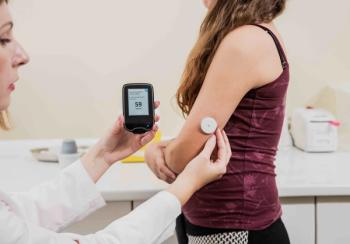
Type 1 Diabetes
Latest News

Managing T1D During Pregnancy With Closed-Loop Insulin Delivery: Camilla Levister
Latest Videos

CME Content
More News

The pump had varying success in reaching recommended glycemic targets among the study participants with type 1 diabetes (T1D).

Camilla Levister on the Nuances of Designing a Pregnancy-Specific Artificial Pancreas System for T1D
Camilla Levister, MS, ANP-C, CDCES, a nurse practitioner at the Icahn School of Medicine at Mount Sinai Hospital in New York, gives insight into the nuances of testing closed-loop insulin delivery systems for pregnant women.

Outside of genetics, which has a well-documented link to the risk of type 1 diabetes (T1D), investigators detail available research spanning a variety of factors, including viral infections, pesticide exposure, and the gut microbiome.

Hospitalized Children With Diabetes May Be Able to Continue Safe Use of Home Pumps, Suggest Findings
Using home insulin pumps when hospitalized was relatively safe compared with hospital-managed pumps and insulin injections among more than 2700 children admitted to a single hospital center.

These findings suggest complement protein levels may be an important biomarker for type 1 diabetes.

Camilla Levister, MS, ANP-C, CDCES, a nurse practitioner at the Icahn School of Medicine at Mount Sinai Hospital in New York, discusses how closed-loop systems benefit patients managing type 1 diabetes.

The findings follow endorsement of the screening measure from the American Diabetes Association, which recommended the practice to identify patients who have type 1 diabetes (T1D) who could benefit from targeted strategies to prevent symptomatic heart failure (HF).

Investigators say adolescents had difficulty adhering to the workbook-based program, but the authors said changes—and perhaps a digital format—could improve the program’s performance.

Having multiple readmissions for diabetes ketoacidosis (DKA) was more likely to occur among patients with type 1 diabetes (T1D) with substance use disorder or who previously were incarcerated.

A new study challenges assumptions about the role of dietary protein and fat in managing blood glucose fluctuations, known as glycemic variability.

A real-world study conducted across 9 European countries found that bolus injection frequency and engagement with a smart pen to administer insulin were associated with improved glycemic control among young adult patients with type 1 diabetes (T1D).

In a systematic review and meta-analysis, real-time continuous glucose monitoring (CGM) demonstrated benefits in terms of time in range, hypoglycemia, and hyperglycemia among patients with type 1 diabetes (T1D).

A study of adolescents with type 1 diabetes (T1D) found that real-time continuous glucose monitoring (CGM) with a predictive hypoglycemia alarm reduced the time spent below range.

A Finnish study found maternal type 1 diabetes (T1D) to be associated with a significantly higher risk of any congenital heart defect (CHD) in offspring, and that maternal overweight or obesity was associated with certain CHDs in offspring.

In recently published data from the phase 3 PROTECT trial, teplizumab slowed the progression of type 1 diabetes in children and adolescents.

Mendelian randomization analyses demonstrated a causal relationship between hypothyroidism and diabetes, along with its related microvascular complications.

Our top-read type 1 diabetes articles of 2023 covered increases in rates of pediatric diabetes early in the COVID-19 pandemic, novel therapies for T1D, and links between patient characteristics and T1D outcomes.

A trial comparing baricitinib against placebo in people with new-onset type 1 diabetes suggests use could contribute to the preservation of β-cell function.

The highest incidence of pediatric type 1 diabetes (T1D) over the past 22 years was seen in Finland, high-income North American regions, and children aged 5 to 14 years.

Researchers concluded there is a clinically important increase in infection risk among patients with T1D in both primary care and hospital settings, and that guidelines must be developed to reflect this risk and encourage earlier treatment.

A study from investigators in Italy sheds further light on the relationship between physical activity and diabetic polyneuropathy risk in patients with type 1 diabetes.

Michael Fang, PhD, researcher and assistant professor in the division of Cardiovascular and Clinical Epidemiology at Johns Hopkins University, discussed recent findings in the type 1 diabetes (T1D) space that may alter the way providers address diabetes diagnoses.

In a systematic and meta-analysis review of cohort studies that featured nearly 1.7 million individuals, study authors concluded that there is an association between high body mass index (BMI) and an increased risk of incident type 1 diabetes.

High glucose variability in children and young adults with type 1 diabetes (T1D) strongly predicted slowed nerve conduction velocity, a forerunner of diabetic peripheral neuropathy, in a recent study.

Results from the AiDAPT trial show hybrid closed-loop therapy significantly improves maternal glycemic control during pregnancy complicated by T1D.















































